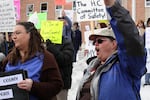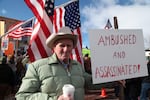After 41 days, an armed occupation at the Malheur National Wildlife Refuge came to a conclusion Thursday morning. The four remaining militants at the refuge surrendered to federal authorities.
Around 9 a.m. Thursday, law enforcement escorted the Rev. Franklin Graham and Nevada state Assemblywoman Michele Fiore from the roadblock outside the refuge to the refuge headquarters. Fiore and Graham then spent about two hours in negotiations with the occupiers.
Husband and wife Sean and Sandy Anderson of Riggins, Idaho, and Jeff Banta of Elko, Nevada, turned themselves in within an hour and a half. David Fry of Blanchester, Ohio, surrendered just after 11 a.m. after speaking with negotiators for about an hour about his viewpoints on the occupation, religion, America as a whole and more.
Related: How A Digital Friendship Created An Unlikely Holdout
Shortly after Fry’s surrender, a convoy of about a dozen law enforcement vehicles, which presumably carried the four occupiers, came back through the roadblock and then, at a high rate of speed, headed back toward Burns. Roads behind the convoy were blocked, preventing other vehicles from following.
In a news conference held later Thursday, FBI Special Agent in Charge Greg Bretzing said the refuge would remain closed for a number of weeks as agents search for explosive and other hazards. He said the FBI will also work to process the crime scene and catalog evidence. Bretzing also acknowledged the toll the occupation has taken on the community.
"Over the course of the last month, the people of Harney County have lived through an experience that is both highly emotional and physically exhausting," he said. "This series of events has been beyond difficult for Harney County families. "
Tense Negotiations And A Surprise Arrest
Around 11 p.m. Wednesday, U.S. Marshals detained Nevada rancher Cliven Bundy, the father of militant leaders Ammon and Ryan Bundy, at the Portland International Airport. He was detained under a U.S. Marshal hold and is facing federal charges.
Wednesday evening was also marked by tense negotiations between militants, the FBI, Fiore and others. The mounting anxiety of federal officials moving in was captured live. As the FBI tightened its perimeter, the remaining four occupiers called online media personality Gaven Seim, who has frequently posted videos in support of the occupation. Seim streamed the call through YouTube.
At one point, the audio feed reached nearly 70,000 listeners.
During the call, Fiore urged the militants to surrender peacefully to law enforcement, and Sean Anderson agreed. He said the group would turn themselves in to the FBI at 8 a.m. Thursday morning. After the militants ended the call to Seim, Cliven Bundy's arrest took place.
In the weeks leading up to the standoff's conclusion, Fry and others used online videos to offer inside accounts of the mounting anxiety playing out at the refuge.
Lost in the final hours of the occupation was the original motive for starting it: the imprisonment of Dwight and Steven Hammond. The militants didn't mention the Harney County ranchers in the closing moments. Instead, they focused on whether they would be able to live to tell their story.
Fiore gave this advice to militant Sandy Anderson about writing her story: “Be detailed Sandy, be very, very detailed,” Fiore said. “Like that author did in Fifty Shades of Grey.”
“The option is you go out there and they get you, and it’s a felony crime and it’s a prison sentence,” Fry told OPB. “A lot of us are scared of that option."
Related: Harney County Officials React To Occupation's End
But communications with the militants were cut off, giving the public little information on how the final days of the standoff played out.
The Unraveling Of An Occupation
The more than five-week occupation began to unravel with the Jan. 26 death of Arizona rancher Robert "LaVoy" Finicum in a confrontation with police.
The leaders of the occupation, including Ammon and Ryan Bundy, were arrested on a rural highway outside of Burns during the incident. The militants were on their way to John Day for a meeting with ranchers in Grant County, Oregon.
In the weeks that followed their arrest, the militants were charged with federal felonies for preventing government workers from carrying out their jobs.
With the leaders in custody, the remaining militants at the refuge continued the occupation. Several abandoned the refuge after hearing word that the leaders were in custody.
Debate swirled in the hours following the death of Finicum regarding how he was killed. In a move uncharacteristic of an ongoing investigation, the FBI released footage of the car chase and police shooting of Finicum.
Occupiers took over the refuge Jan. 2 during a rally for Harney County ranchers Dwight and Stephen Hammond. The two turned themselves in to federal prison earlier this month after being convicted of arson on federal land.
Related: Malheur Occupation: A Reference Guide
The occupiers said they came to Harney County to defend the Hammonds and protest the federal government's role in managing public lands. A group of armed militants, including the Bundy brothers and Finicum, took over the Malheur refuge right before the rancher's imprisonment. They called on the federal government to release the Hammonds and turn the wildlife refuge over to county's residents.
A Community Divided
Bundy's group said the ultimate goal was to create a county free of the federal government. But the Bundys' agenda was controversial, even for the close-knit ranching community they said they sought to help.
Weeks into the occupation, the Bundys called on ranchers across the nation to tear up their federal grazing leases. The move caused a schism in the community over what role the government should have in the lives of ranchers.
Divisions in the community were evident at meetings led by local officials. Some residents saw the armed takeover of the federal buildings as a heroic stand against the federal government. While others saw the group more as armed outsiders using their community as a platform to advance their own agenda.

A police officer steps in between BJ Soper, of the Pacific Patriots Network, and counterprotesters in Burns, Oregon.
Amelia Templeton / OPB
As the occupation continued, it took a toll on federal employees in Harney County, especially those who worked at the refuge. The U.S. Fish and Wildlife Service removed their workers from the county after militants made numerous threats.
"I would say this is the most disrupted my life has ever been," said one frustrated and angered employee.
OPB agreed to withhold the identity of the employee because armed militants who took over the refuge have made threats against federal employees.
“Knowing that they’re combing through all of our files, everything that we have that’s government and personal at the refuge, that they have access to our computers, that they know everything from my Social Security number to my shoe size,” the current employee said, “it’s a great sense of violation.”
Law enforcement were criticized throughout the armed occupation for appearing to be removed from the ongoing situation. Roads in and out of the refuge remained opened in the early weeks, allowing militants to move freely and re-supply. But their defenders argued officials were trying to avoid another Waco or Ruby Ridge level event from erupting.
The occupation drew supporters and critics from across the country. Like minded protesters from outside Oregon, many with anti-government sentiments, joined the Bundys at the refuge.
Supporters of public lands staged local and regional counter protests. While others criticized the occupation online in a variety of creative ways, including erotic fan fiction and the mailing of sex toys to the compound.
Locally, most Harney County residents said they wanted the occupiers gone.
“Armed protesters don’t belong here," said Charlotte Roderique, tribal chair for the Burns Paiute tribe. The tribe was among the most vocal critics of the armed takeover.
“By their actions, they are endangering one of our sacred sites," Roderique said. The refuge building alone holds more than 4,000 cultural artifacts.





